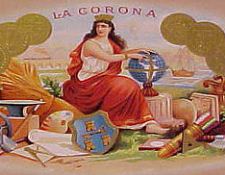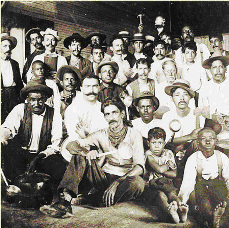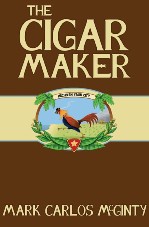Cigar Insider: Behind the Scenes at the Local Cigar Club
12 Oct 2011
Cigar clubs are a great way to get together with friends, try some new cigars and spirits, check out a local cigar shop that you’ve never found time to visit, and sit and bond with your fellow cigar enthusiasts. Women have book clubs, men have cigar clubs. I recently sat down with Paul Medenwaldt, president of The Havana Nights Cigar Club from the Twin Cities, who gave me the lowdown on running a cigar club.
 The club meets on the first Tuesday of every month at a shop called Little Havana Tobacco in Anoka, Minnesota. Started by a group of guys who wanted to get together with like-minded people and try new cigars, it also became a vehicle for a local cigar shop to bring more people through its doors—people who otherwise might have never stopped by.
The club meets on the first Tuesday of every month at a shop called Little Havana Tobacco in Anoka, Minnesota. Started by a group of guys who wanted to get together with like-minded people and try new cigars, it also became a vehicle for a local cigar shop to bring more people through its doors—people who otherwise might have never stopped by.
When I asked Paul about the club’s membership and their experience as cigar smokers, he had this to say: “Most of the cigar club members are not guys that hang out on a frequent basis at cigar shops. This is their one day a month to get together with friends they may only see once a month. Most of the cigar members are beginners, but have been developing their palate over the years with the introduction to new cigars that the club smokes.
“We try to get new cigars that come to market that the members normally would not know about or try. A lot of them know what they like and only smoke those cigars, but if they enjoy a cigar the evening of the club, they will then search it out at their local shop or online.
“There are only a handful of guys who are hardcore cigar smokers that frequent local cigar shops multiple nights a week and know what cigars are available in the market. The same can be said for the spirits we sample. We do our best to present the members with unique whiskeys they would not have in their own collection, like Ardbeg or Highland Park.â€
When it comes to picking cigars, like a book club would pick a book, the club tries to focus on new cigars that have come to market. “After the yearly IPCPR event,†says Paul, “I will search out cigars that manufacturers are introducing to the market. This October we are featuring the new CAO OSA Sol. It’s the first release from CAO since being acquired by General Cigar.â€
But with so many new cigars to choose from, how do they decide on only one per month? “The difficult part is trying to select from so many new blends. I almost wished we met on a more frequent basis so we could have the opportunity to try all the new cigars. Our club for years voted on the following month’s cigars and spirits. The last few years the club members have put that decision in the hands of the president.â€
It’s easier for one person to pick the cigar than for 30 people to decide. And some of the members don’t really care what gets smoked, they just want to socialize and try new things. There are monthly dues which go towards the purchase of cigars and spirits, so when you arrive on club night, your cigars and drinks are already there. The club also holds raffles for cigars and cigar accessories.
When I asked Paul for advice on starting a cigar club, he offered the following words of wisdom: “It’s finding like-minded people who can make a commitment once a month and are willing to try cigars they may not of tried otherwise.”
He continued: “Decide on what the purpose of the club will be. Is it an evening where people get together and just smoke a cigar and have a spirit? Will the focus be to review the cigar you are smoking and to publish those results for the rest of the world to see?
“Starting with core members who are dedicated to cigars, the word will get out and others may be interested in joining. Have the club meetings on a weekday. It may sound weird, but more people are available on weekday evenings (they are then less likely to get stinking drunk because they have to get up the next morning). But the focus should be on the cigar.â€
The Havana Nights club often works with local cigar shops that are open to hosting a meeting. Some shops may be willing to stay open later if it means new cigar smokers will be visiting their shops. Shops will always have new cigars they are willing to promote to new people the evening of the cigar club.
“My experience is that I am selective when it comes to new members. You want to make sure they are there for the cigar and fellowship and not just for an evening of drinking. Start with core members who are knowledgeable and then find people who may be novices to cigar smoking but are willing to learn about new cigars. The challenge will be getting to those novices because they probably don’t hang out on a regular basis at a cigar shop and may only walk in and walk out of a cigar shop with their purchase or are online only purchasers.
“It’s about getting the word out there that a cigar club is available in a local area and using a simple website and social media to provide people with information about the club. Work with a local cigar shop, hang flyers in the shop promoting the club, and explain how it will differ from their regular visits to the cigar shop. You have to give the people a reason to show up. And write a simple constitution for the club so new members can read what they expect to get out of the club.â€
Once a club is up and running it pretty much takes care of itself. Paul will arrive early to make sure all the cigars and spirits are ready for when the members arrive and greet each member as they walk in.
I had the pleasure of spending an evening with the Havana Nights Cigar Club and found it to be a very relaxed atmosphere dedicated to discussing cigars, sports, food, and whatever it is men talk about when they get together. You can imagine that I had a pretty good time. If anyone would like advice on starting or running a cigar club, Paul Medenwaldt welcomes your emails.
photo credit:Â Flickr

 Lisa Figueredo: I owed an ad agency and was up late one night working and was thinking of when my Abuelo Lee and Abuela Nena would have fresh hot Cuban bread and butter waiting for me when I woke up with some hot café con leche. Then my Abuela Nena and I would catch the bus and ride over to Ybor City for the day or sometimes my Abuelo Lee would take me to the local cigar factories to pick up the steams and waste from the tobacco leaves that he would use to spread on people’s lawns. I was thinking about how much I missed them and how I wished I could get those days back. That’s when I came up with the idea to write about my stories and the history of Tampa.
Lisa Figueredo: I owed an ad agency and was up late one night working and was thinking of when my Abuelo Lee and Abuela Nena would have fresh hot Cuban bread and butter waiting for me when I woke up with some hot café con leche. Then my Abuela Nena and I would catch the bus and ride over to Ybor City for the day or sometimes my Abuelo Lee would take me to the local cigar factories to pick up the steams and waste from the tobacco leaves that he would use to spread on people’s lawns. I was thinking about how much I missed them and how I wished I could get those days back. That’s when I came up with the idea to write about my stories and the history of Tampa. You pick up this box of cigars for a closer look at this pretty girl—she’s the centerpiece of a brilliant arrangement of symbolic imagery, a romantic fantasy world meant to satisfy you, and you only.
You pick up this box of cigars for a closer look at this pretty girl—she’s the centerpiece of a brilliant arrangement of symbolic imagery, a romantic fantasy world meant to satisfy you, and you only. Sources can’t agree on the number of men involved, but somewhere between 6 and 16 cigar workers were kidnapped by a group of vigilantes, deported by boat to a deserted beach in Central America, and warned to never be seen in Tampa again. Well, those brave men eventually made it back to Tampa. Their story has been fictionalized in the novel
Sources can’t agree on the number of men involved, but somewhere between 6 and 16 cigar workers were kidnapped by a group of vigilantes, deported by boat to a deserted beach in Central America, and warned to never be seen in Tampa again. Well, those brave men eventually made it back to Tampa. Their story has been fictionalized in the novel  The SS Olivette returned to busy Port Tampa the following evening. Freighters loaded with cigars set sail for Texas and Mexico while cargoes of fresh produce arrived from Honduras, and tobacco from Cuba. Mendez saw that the front page of Kincaid’s Daily News bore the headline “Cigar Workers Strike,†with a photograph of the Vasquez factory. Beside the picture was the smaller headline: “Decree to Workers: Return to Work Now or Face Employment Blacklist.â€
The SS Olivette returned to busy Port Tampa the following evening. Freighters loaded with cigars set sail for Texas and Mexico while cargoes of fresh produce arrived from Honduras, and tobacco from Cuba. Mendez saw that the front page of Kincaid’s Daily News bore the headline “Cigar Workers Strike,†with a photograph of the Vasquez factory. Beside the picture was the smaller headline: “Decree to Workers: Return to Work Now or Face Employment Blacklist.â€ Angel Cuesta and Peregrino Rey, both in their thirties when they started the famous cigar company in 1896, were just a pair of entrepreneurs in a city with dozens of cigar factories. In fact, the Tampa Tribune thought so little of them that the newspaper didn’t even bother to check the spelling of their names and with little fanfare, announced that Cuesta Ray [sic] had formed in Ybor City, Florida, employing 100 workers. The paper would have never expected this pair of young Spaniards to create a revolutionary cigar company that would set industry standards for quality and marketing and become one of the most recognized brands in the world.
Angel Cuesta and Peregrino Rey, both in their thirties when they started the famous cigar company in 1896, were just a pair of entrepreneurs in a city with dozens of cigar factories. In fact, the Tampa Tribune thought so little of them that the newspaper didn’t even bother to check the spelling of their names and with little fanfare, announced that Cuesta Ray [sic] had formed in Ybor City, Florida, employing 100 workers. The paper would have never expected this pair of young Spaniards to create a revolutionary cigar company that would set industry standards for quality and marketing and become one of the most recognized brands in the world.
 Patrick Ashby
Co-Founder & Editor in Chief
Patrick Ashby
Co-Founder & Editor in Chief Patrick Semmens
Co-Founder & Publisher
Patrick Semmens
Co-Founder & Publisher George Edmonson
Tampa Bureau Chief
George Edmonson
Tampa Bureau Chief